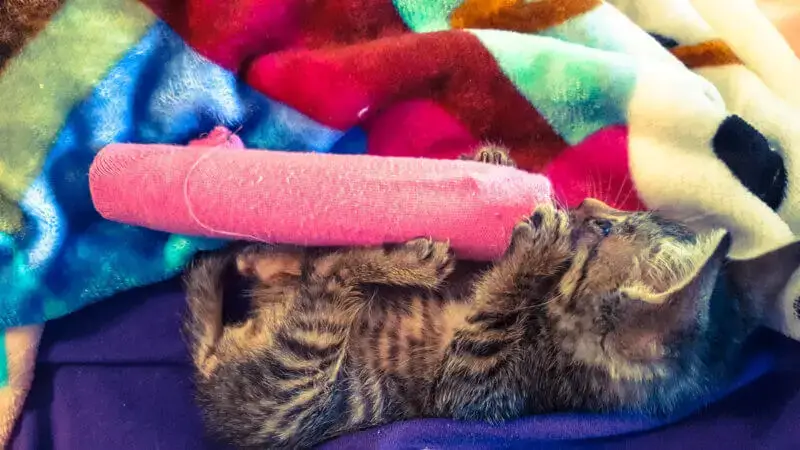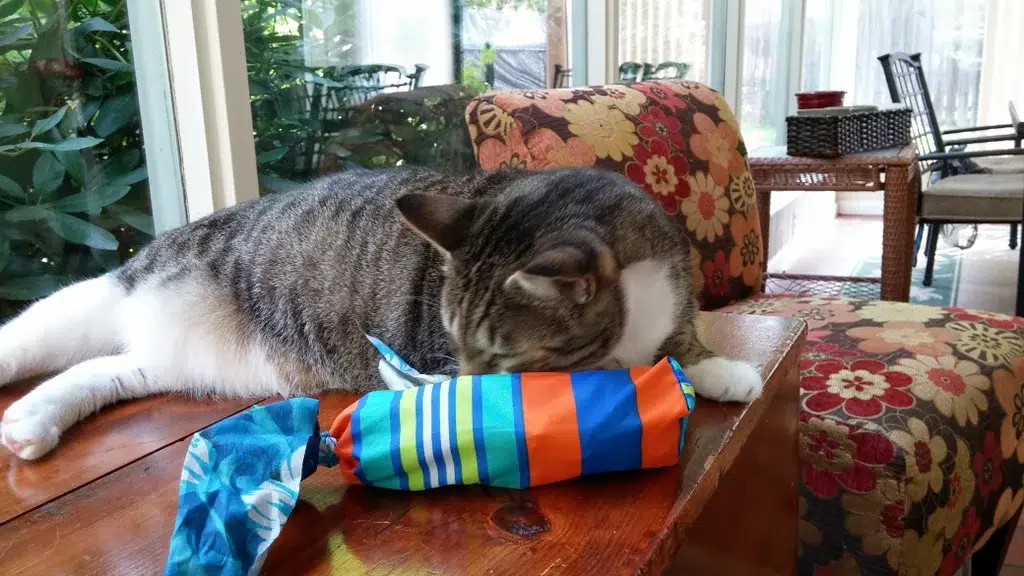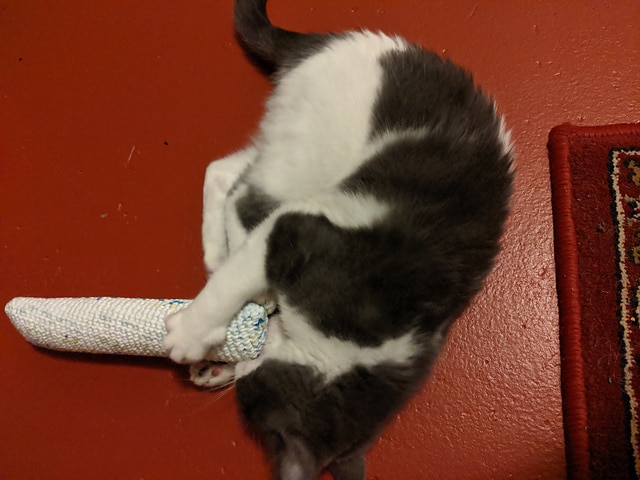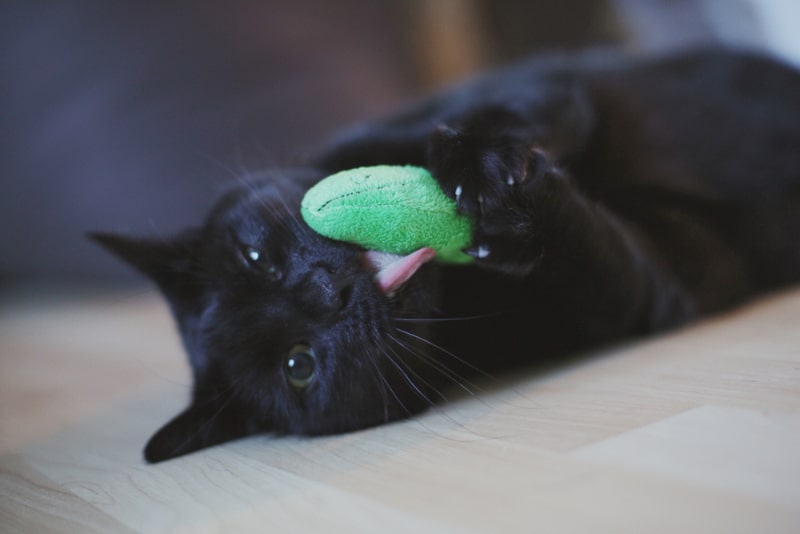There’s nothing quite as adorable as a kitty hugging and rapidly bunny kicking their favorite toy. Kicker toys are more than just a fun plaything, though; they’re designed to cater to your kitty’s natural hunting instincts. These toys are relatively simple to make, especially if you consider yourself handy with a sewing machine. Read on to find seven cat kickers you can make today with supplies you probably already have on hand.
The 7 DIY Cat Kicker Toys
1. Cat Pillow Kicker by Needle Pointers

| Materials: |
Scrap fabric, polyester polyfill, dried catnip, basic sewing supplies
|
| Tools: | Sewing machine, ironing board, iron |
| Difficulty Level: | Moderate |
This pillow kicker from Needle Pointers is a relatively simple and cheap DIY project you can put together in 15 minutes with scraps you already have in your sewing kit. You’ll start by cutting your piece of fabric into an 8″ x 12″ rectangle and then pressing the short ends under the wrong side half an inch. Next, fold the fabric lengthwise, aligning the raw edges and pinning the fabric. Using a straight stitch at your sewing machine, sew the long seam using a half-inch seam allowance. Turn the tube right side out and edgestitch on one short end. Finally, stuff the tube with your stuffing and catnip, alternating until the roll is full. Finish off by edge stitching it closed.
2. Kicker with Refillable Catnip Pocket by Creative Animal Crafts
| Materials: | Fabric, polyfill, hook and loop tape, basic sewing supplies |
| Tools: | Scissors, sewing machine |
| Difficulty Level: | Moderate |
This kicker toy with a refillable catnip pouch by Creative Animal Crafts is a great beginner sewing project. It’s much similar to the DIY above, except you’ll use hook and loop tape on one end of the tube, which allows you to refill the toy’s catnip pocket when it gets low. You’ll still stuff it with a polyfill fabric to make it soft for when your kitty inevitably hugs and bunny kicks it, but that catnip pocket at the top sets this project apart from the one above.
3. Cardboard & Sock Kick Stick by Veggie Converter

| Materials: | Cardboard tubes, a sock, uncooked rice, catnip |
| Tools: | Needle and thread |
| Difficulty Level: | Beginner |
This cardboard and sock kick stick from Veggie Converter is a good project for beginner sewers who aren’t quite comfortable yet with a sewing machine. You’ll start by placing your cardboard tube inside a single sock. Fill the tube until it’s almost full with uncooked rice, and add in catnip. Close the sock and tie it off with a needle and thread or even a piece of scrap fabric or ribbon if you don’t have sewing supplies on hand. Shake it up to mix the ingredients, and then toss it to your kitty to enjoy!
4. Upcycled Umbrella Cover Kick Toy by Umbrella Upcycle

| Materials: | Umbrella cover, crinkly packaging, strip of fabric, catnip |
| Tools: | None |
| Difficulty Level: | Beginner |
Umbrella covers are kind of useless, so give your unused ones a new life by converting them into a kick toy! This upcycled umbrella cover toy from Umbrella Upcycle is super easy to put together with supplies you probably already have. First, grab your crinkly packaging and crumple it. You can use literally anything that makes a crinkly sound here – bread bags, plastic bags, cereal bags, etc. Put your crinkly material inside the umbrella cover and tie the open end closer with a strip of fabric or ribbon. You can also place catnip inside with the crinkly bags if you wish.
5. Catnip Cigar Kicker by Ruffings

| Materials: | Fabric, basic sewing supplies, catnip |
| Tools: | Printer, scissors, sewing machine, steam iron, scissors |
| Difficulty Level: | Moderate |
This catnip cigar kicker from Ruffings is a relatively easy DIY project for someone comfortable with a sewing machine. The creator provides templates to make it even easier, so all you need to do is sew right on the lines you’ll draw on your fabric. Instead of filling your “cigar” with polyfill, as with some of the other DIYs above, you’ll stuff it right full of catnip!
6. Crocheted Kicker Toy by Crochet Cryptid

| Materials: | Yarn, filler |
| Tools: | Crochet hook and basic crochet supplies |
| Difficulty Level: | Moderate |
If you prefer crocheting over sewing, this kicker toy from Crochet Cryptid will be right up your alley. The original creator used half a skein of yarn, though you can make your own toy bigger or smaller depending on your needs by adjusting how much you chain at the start of your project and how many rows you do. Cotton is recommended versus acrylic for this project, as the latter often fuzzes up. You can choose how to stuff your kicker with polyfill, catnip, bags, or anything else you think your kitty would get a kick out of (pun intended).
7. Shamrock Kick Toy by Catventurous Crochet
| Materials: | Yarn, catnip, stuffing |
| Tools: | Crochet hook, scissors, sewing needle |
| Difficulty Level: | Moderate |
This shamrock kick toy from Catventurous Crochet is another great DIY for people handy with crochet hooks. While this toy isn’t tube-shaped like others on our list, it’s still an awesome toy for cats who need to let their natural hunting instincts shine. You’ll need to be familiar with a few stitches, such as the magic ring, chain, single/double/triple crochet, and half-double crochet. The tutorial is pretty thorough, so watch it through a time or two if you’re not quite familiar yet with some of those stitches.
Frequent Asked Questions
What’s the Ideal Kicker Toy Size?
Store-bought kicker toys will vary in length, though most fall in the seven to 12-inch range. However, since you’re making your own, you can choose the size that best suits your kitty. The perfect size will depend on the age and size of your kitty. You’ll want it to be just the right length so that your cat can grab the toy with their front paws to hold it in place and still be able to kick it with their back legs. You might consider trying different sizes and shapes to see which your cat prefers.
How Can I Encourage My Cat to Play With Their New Toy?
Nothing is as disheartening as creating something by hand and not having the recipient respond as you were expecting them to. If your cat isn’t showing interest in their new toy, you might consider spraying it with catnip to catch their attention.
Unfortunately, there isn’t a way to get a cat to start playing with a specific toy as they march to the beat of their own drum. Not all cats enjoy all types of toys, so if yours doesn’t take to their new kicker toy right away, don’t be offended. Take it away for a while and then reintroduce it in a day or two to see if it piques their interest.

To Add Catnip or Not to Add Catnip?
That is the question, isn’t it? Should you or should you not use catnip while making your kitty’s new kick toy?
Well, it depends. You absolutely do not need to add catnip to your kick toys if your cat isn’t affected by catnip or if you don’t have any on hand. Some people don’t like giving their cat a catnip every day as it can lose its effect with too much use. You might then consider making two kick toys if you have the materials on hand, one with catnip and one without.

Final Thoughts
DIY kicker toys are relatively simple to make, especially if you’re comfortable with using sewing machines. If you couldn’t sew or crochet a stitch to save your life, you’ll probably have the best luck with projects number three and four since they don’t require any specialized equipment like that.
Featured Image Credit: Ellie-Burnett, Shutterstock
Contents
- The 7 DIY Cat Kicker Toys
- 1. Cat Pillow Kicker by Needle Pointers
- 2. Kicker with Refillable Catnip Pocket by Creative Animal Crafts
- 3. Cardboard & Sock Kick Stick by Veggie Converter
- 4. Upcycled Umbrella Cover Kick Toy by Umbrella Upcycle
- 5. Catnip Cigar Kicker by Ruffings
- 6. Crocheted Kicker Toy by Crochet Cryptid
- 7. Shamrock Kick Toy by Catventurous Crochet
- Frequent Asked Questions
- What’s the Ideal Kicker Toy Size?
- How Can I Encourage My Cat to Play With Their New Toy?
- To Add Catnip or Not to Add Catnip?
- Final Thoughts











